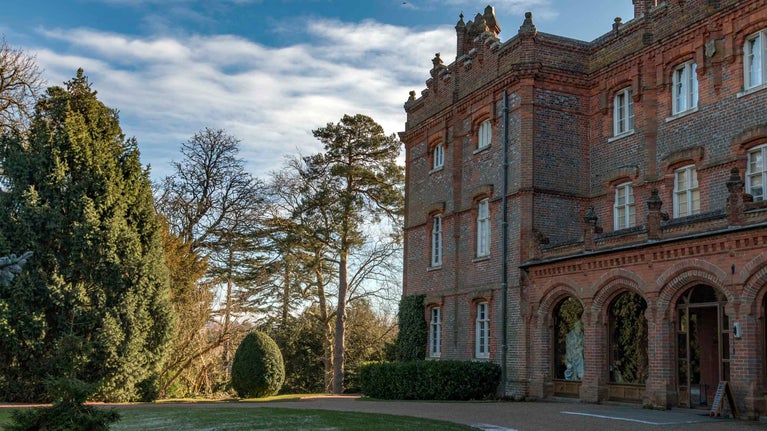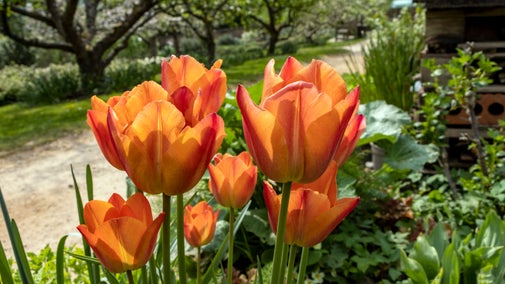
Discover more at Hughenden
Find out when Hughenden is open, how to get here, the things to see and do and more.

Explore this house with two tales. Once a home to Queen Victoria’s favourite Prime Minister and friend Benjamin Disraeli, the manor provided a backdrop for political drama, royal visits, and an enduring love story. However, it has an equally significant 20th-century story to tell in becoming the base for a top-secret map-making operation during the Second World War. Explore the rooms that uncover these stories.
Statesman Benjamin Disraeli and his wife Mary Anne had a significant influence on the styling of the country manor you see today. Disraeli hired architect Edward Buckton-Lamb to complete the transformation of Hughenden from a Georgian white stuccoed building into a Victorian country retreat. As you move through the rooms you will see the personalities of both husband and wife reflected in their tastes, and their status as rising members of Victorian high society.
Disraeli purchased Hughenden in 1848, shortly after becoming leader of the Conservative Party. Securing the manor was vital to the realisation of his political ambitions and his personal aspirations, and elevated him to the status of landed country gentleman.
In the main house the rooms are recreated as Disraeli would have known them, with the library full of his beloved books and the dining room set for Queen Victoria’s visit in 1877.
On the first floor is his study, bedroom and Mary Anne’s boudoir along with the black silk robe worn by Disraeli as Chancellor of the Exchequer, which he notoriously refused to give up. A special display ‘Treasured’ celebrates 125 years of National Trust care, through pieces from the Hughenden collection with a story to tell.
The rooms in the west wing tell the story of Hughenden’s requisition by the Air Ministry in 1941 when the manor became home to a secret map-making operation, code-named Hillside.
Entrance is allocated on arrival at the house by showing a valid visit ticket receipt or National Trust membership card. Numbers are limited for safety and on a first-come first-served basis, so please be aware that entry to the house is not guaranteed on busy days.
The arched, red brick arcade that you walk through as you enter was originally open air. Plate glass was added later, in the 1870s. The two large statues depict Benjamin Disraeli in his robes as a member of the Order of the Garter, and Edward Stanley (14th Earl of Derby) who was a Tory MP and appointed Disraeli to the position of Chancellor of the Exchequer in three of his governments.
As you walk into this space, the striking vaulted, ribbed ceiling above, with the Disraeli crest, is the first thing you see. The many cosy features like the brass and cast-iron stove with encaustic tile decorations (decorated by burning in coloured clays and dyes) were added by Disraeli. Mary Anne always ensured the fire was lit ready for when Benjamin returned from London.

The Inner Hall was a space where the Disraelis displayed prestigious objects, from portraits of friends and family to interesting furniture. Such displays would be viewed by guests as they waited to be received by the household.
The centrepiece of this room is a large portrait of the famous poet Lord Byron, one of Disraeli’s literary heroes. In it, he is surrounded by political and diplomatic figures including French Emperor Napoleon III.
Often known as Disraeli’s ‘Gallery of Affection’, the staircase and corridor are home to many portraits of Disraeli’s closest friends and colleagues.
Figures depicted include Horatio Walpole (Conservative MP and peer, who gifted his portrait to Disraeli as a sign of their friendship), Sir Nathaniel Rothschild (a close friend of Disraeli’s, serving as the principal trustee of his estate), Lord Denison (Speaker of the House of Commons, 1857-1872) and Robert Cecil (who served as Secretary of State for India, 1874-1878, and as Foreign Secretary, 1878-1880 under Disraeli).
Hughenden’s library contains 3,373 books, the oldest dating to 1477. Disraeli’s love of books was a trait inherited from his father, Isaac D’Israeli, who was a well-known scholar and author and who amassed a collection of over 25,000 volumes which he passed on to his son.
Many of the books were sold to cover Disraeli’s personal debts, but those still in the collection cover subjects encompassing history and politics, religion and philosophy, travel works and poetry. Looking up, you will see the ceiling depicts scenes from Aesop’s fables, a favourite book of Disraeli’s when he was young, and his shark-skin globe and blotter can still be found on his desk.
The drawing room takes its name from an 18th-century practice, where ladies were expected to ‘withdraw’ to a cosy space after supper to socialise. The Drawing Room at Hughenden Manor was therefore Mary Anne’s domain: a space to relax, but also to show off her personal tastes.
The gilt porcelain and ormolu chiffonier are highlights of the space. Amongst some Victorian ladies was a preference for bold, rococo styles and gilt decorations, and drawing rooms were often organised to show off their most valuable possessions. The ‘B chair’ was embroidered by Mary Anne herself and captures her excitement at being created Viscountess Beaconsfield in 1868.

The Garden Hall provided direct access to the Italianate Garden. It was designed by Mary Ann to create a romantic feel, originally complete with a metal pergola full of hanging plants overlooking a sunken garden with organised beds and classical statuary.
The Gothic oak armchair was specifically carved for Disraeli by John Baldwin in 1853. The detailed decoration on the chair, which includes a cockatrice - a mythical animal depicted as a two-legged dragon with a cockerel’s head - carved on the right arm and a basilisk on the left, is meant to be an interpretation of the prophecy of Isaiah.
The portraits in the space include those of James Clay, Edward Bulwer-Lytton and George Manners, fellow MPs and political characters who inspired and worked alongside Disraeli during his career.
Few figures of the Victorian age were as enigmatic as Benjamin Disraeli. A Jew, a Christian, an author, a politician: Disraeli defied classification and expectation in every aspect of his life. These aspects of his life are the focus of the display in the Disraeli Room.
Whether through the symbols Disraeli integrated into his coat of arms, seen in the different seals he used, of the Sephardic castle, or the portrayal of Disraeli’s character and dress in Punch magazine, there are multiple elements to Disraeli’s character and how he used his status as an outsider to grow his success.
During the 1940s Hughenden was the site of a top-secret operation, codenamed Hillside. Men and women, both civilian and RAF, were working on the production of target bombing maps which were used to help end the Second World War.
The west wing rooms explore the story of the work and lives of the people who were based here. Original maps show the new simplified format that target bombing maps had to take, each detail of which was hand-drawn by those at Hillside.
Hear from some of the map makers themselves in the audio-visual display and see some of their personal items related to their time at the manor.

Find out when Hughenden is open, how to get here, the things to see and do and more.
Find out more about the history that surrounds this estate, from early Domesday records to becoming the home of Queen Victoria’s favourite Prime Minister, Benjamin Disraeli.

Enjoy the symmetrical flower beds, clipped topiary and stonework of the formal garden design, or take a wander through the productive beds of the walled garden.

Explore the parkland on one of three colour-coded walks, with its carefully designed views, rare chalk stream and medieval church.

Enjoy light snacks, hot meals and drinks in the café, then have a browse in the shop or pick up a bargain in the second-hand bookshop.
